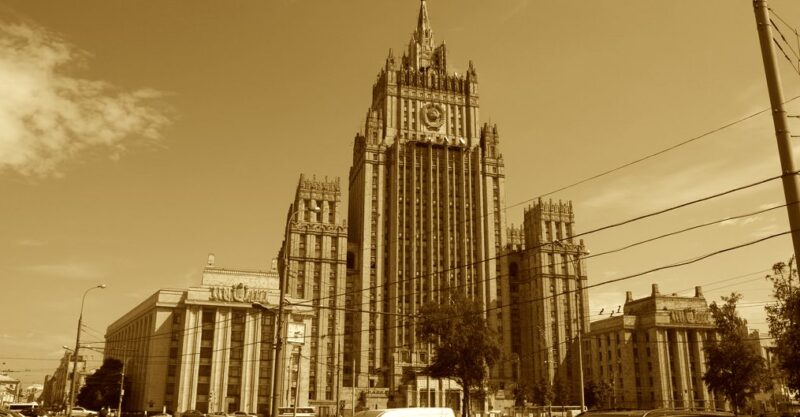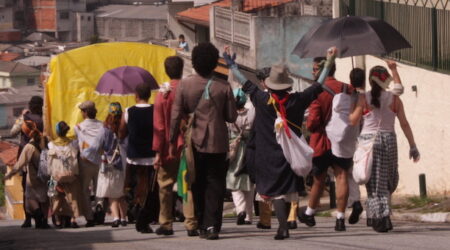If you find yourself walking the streets of downtown Moscow and stop to make a 360 degree turn, chances are good that you will spot at least one tall, Gothic-style skyscraper at some point in the distance. A total of seven of these skyscrapers, known collectively as vysotki (a play on vysota, the Russian word for “height”), appeared on the Moscow cityscape between 1952 and 1959, making them the Soviet Union’s first modern skyscrapers. To this day, they remain the sites of some of the city’s most important political and cultural institutions, including the Ministry of Foreign Affairs and Moscow State University. Clocking in at upwards of 787 feet in height, each vysotka stands distinctly apart from her neighbors, most of which struggle to register at twenty stories. Like Paris’s Eiffel Tower and New York’s Empire State Building, their size and distinct styles have earned them coveted spots on backlit renderings of the Moscow skyline, cementing their status as both iconic and ordinary fixtures within the capital city’s built environment.
Difficult as these buildings are to ignore in real life, they have managed to remain invisible within the scholarly literature. Historians of the Soviet Union and experts on socialist cities have paid scant attention to these structures, focusing instead on the experimental architecture of the 1920s Soviet avant-garde and the 1930s Stalinist neoclassical period.
 “The buildings have been pretty much dismissed by history,” says Katherine Zubovich, a doctoral candidate in Russian and Soviet History at UC Berkeley. Zubovich’s dissertation, titled “Moscow Monumental: Soviet Skyscrapers and Urban Life under High Stalinism,” seeks to fill this gap by chronicling the history of the skyscraper project and its impact on the city of Moscow. More than a blueprint-to-bricklaying story, Zubovich’s dissertation charts the skyscraper project’s political, economic, and social dimensions, as well. From the buildings’ origins in US-USSR architectural relations in the 1930s to their development in the hands of the Soviet Union’s most powerful state bureaucracies, not to mention their impact on the everyday lives of ordinary Muscovites, the vysotki, Zubovich argues, transformed Moscow from a provincial former Russian capital into the showcase socialist city.
“The buildings have been pretty much dismissed by history,” says Katherine Zubovich, a doctoral candidate in Russian and Soviet History at UC Berkeley. Zubovich’s dissertation, titled “Moscow Monumental: Soviet Skyscrapers and Urban Life under High Stalinism,” seeks to fill this gap by chronicling the history of the skyscraper project and its impact on the city of Moscow. More than a blueprint-to-bricklaying story, Zubovich’s dissertation charts the skyscraper project’s political, economic, and social dimensions, as well. From the buildings’ origins in US-USSR architectural relations in the 1930s to their development in the hands of the Soviet Union’s most powerful state bureaucracies, not to mention their impact on the everyday lives of ordinary Muscovites, the vysotki, Zubovich argues, transformed Moscow from a provincial former Russian capital into the showcase socialist city.
So what explains the skyscrapers’ absence from the scholarly literature? The answer, Zubovich thinks, lies in their moment of creation. The first of the seven skyscrapers was completed in late 1952, during the final months of Joseph Stalin’s life. Over the next several years, one vysotka after another was completed, each popping up like an unlikely daisy in the middle of winter. Winters, however, thaw into spring. As Stalin’s successor, Nikita Khrushchev, began to unroll a series of “de-Stalinization” policies meant to distinguish his regime from his predecessor’s, the skyscrapers came to be viewed not as shiny new additions to the Moscow cityscape, but as unwelcome, outdated reminders of a darker era.
 In short order, the buildings’ architects came under attack by Stalin-era elites in search of scapegoats for Stalin’s (and their own) misdeeds. Khrushchev, himself a major beneficiary of Stalin’s patronage, joined the chorus of critics at a builder’s conference held in Moscow in December 1954. “Right as they were being realized, these buildings became villains on the Moscow cityscape,” Zubovich notes. The new regime tried to counteract the influence of these steely giants through large-scale, pre-fabricated public housing developments designed to represent a more humane and inclusive brand of socialist humanism.
In short order, the buildings’ architects came under attack by Stalin-era elites in search of scapegoats for Stalin’s (and their own) misdeeds. Khrushchev, himself a major beneficiary of Stalin’s patronage, joined the chorus of critics at a builder’s conference held in Moscow in December 1954. “Right as they were being realized, these buildings became villains on the Moscow cityscape,” Zubovich notes. The new regime tried to counteract the influence of these steely giants through large-scale, pre-fabricated public housing developments designed to represent a more humane and inclusive brand of socialist humanism.
Almost before they could open their doors, the buildings became not just politically but aesthetically problematic. Many condemned the buildings as unoriginal, copycats of American skyscrapers like Chicago’s Sears Tower and New York’s Empire State Building. The same criticism was leveled against the engineering technique used to build them. “There was a sense that these buildings were regressive in their time, that they weren’t technologically innovative, that they were just borrowing technology from abroad that was old technology,” Zubovich says. Like the White Sea Canal and the Dnieprostroi Dam, the skyscrapers were built in part using the labor of convicts paced at a breakneck speed, further cementing the project’s reputation as a Stalinist hallmark.
Contemporary audiences and scholars have in some ways perpetuated the buildings’ original reputations as Stalinist holdovers, so much so that many have branded the vysotki as mere examples of “totalitarian architecture,” on par with buildings like Albert Speer’s Zeppelinfeld stadium or the Mussolini-commissioned Palazzo della Civiltà Italiana. But Zubovich argues that their “totalitarian” label is somewhat misplaced. While she concedes that the buildings were supposed to, and did, restructure the city and re-orient the individual’s command of the urban space, the way the project unfolded does not adhere to the top-down, one-way trajectory that the “totalitarian” genre implies.
For example, Zubovich describes how the buildings were intended to be part of a monumental, totalizing plan for Moscow, dominated by what contemporaries termed the “socialist realist ensemble”: a trio consisting of a monumental skyscraper, connected to long, wide boulevards that in turn led to public parks and places of leisure. But what Zubovich’s research has uncovered is that a plan driven by the aesthetic ideal of ordering and controlling space came to be shaped more by the people who occupied it. Rehousing individuals living on the plots intended for skyscraper development, managing tenancy requests, and transporting workers from outside the city center to build the structures themselves were just some of the human aspects that the original plan failed to consider and ultimately had to accommodate. “I soon realized that [a project that] started as a very short decree in January 1947 unraveled into many, many subsequent decrees that had to be written to take into account so much of the fallout of this project,” Zubovich recalls. The project, in other words, was totalizing in scope rather than effect. Rather than dwarf or subordinate the individual, it incorporated and adjusted to human necessity.
Another reason why the vysotki’s “totalitarian” label warrants reconsideration rests in the project’s institutional origins. During her research, Zubovich followed a paper trail that linked the vysotki to similar projects in the United States and Europe, underscoring the fact that the initiative had closer ties to architectural movements in liberal western states than to fascist ones.
In the early 1930s, nearly two decades before the first vysotka opened its doors, the Central Committee of the Communist Party announced plans to build a new government headquarters that would also double as the world’s largest skyscraper. The commission for the “proletariat tower,” later rebranded as the “Palace of Soviets,” fell in the hands of architect Boris Iofan, whose first major work, the “House on the Embankment,” was home to the most powerful members of the Stalinist elite at the time. In 1934, early in the Palace’s planning stage, Iofan led a team of Soviet architects on an exploratory trip to the United States to conduct detailed technical studies of major American building projects. There he signed a contract with the celebrated, New York-based engineering firm Moran & Proctor to provide engineering consulting for the Palace of Soviets project, and he spent time surveying some of the United States’ most innovative skyscrapers. Buildings like Detroit’s Fisher, Union Trust, and General Motors Buildings, Chicago’s Tribune Tower, and New York’s Empire State, Woolworth, and Chrysler Buildings convinced Iofan that the world’s greatest building in the world’s greatest socialist city needed and deserved the best in technical expertise, even if it came from the heart of the capitalist west. Iofan would recycle this knowledge and embrace of western technological expertise after the Soviet government sidelined the Palace of Soviets project in the early 1950s, redirecting resources to developing what would become Moscow’s signature seven skyscrapers.
Yet despite its ties to American and European architectural know-how, the skyscraper project, according to Zubovich, can be best appreciated as a socialist enterprise, and a Soviet one at that. From their composition (steel, marble, iron) to their construction timeline (fast) and sponsors (the public sector), the skyscrapers bore the traits of a socialist economy forged under Joseph Stalin’s tutelage in particular. “The thing about building in a socialist context is that you can’t just flip through a catalog and figure out the materials you want to order from a certain company,” Zubovich points out. “You [the state] are the company.”
Absent a private sector, Soviet state bureaucrats had to manage (and in some cases create) a reliable supply chain capable of sustaining a decade’s worth of metropolis-building. From creating agreements with marble quarries far from the city center to building the transportation infrastructure necessary to transport raw materials to the construction sites, the demands that the project imposed on the agencies involved amounted to yet another source of stress for a government still recovering from the disaster of World War II. Building up, the project’s members realized, required first building across.
But build they did, and the final products—seven skyscrapers, each filled with residential, commercial, and professional occupants—testify to the power of the skyscraper as an idea to shape policy and space. It was an idea that many modern states, socialist and not, contemplated and pursued during the 19th and 20th centuries for practical and ideological purposes. When asked why city planners are attracted to extraordinarily large buildings, Zubovich stresses their symbolic value and ability “to make a statement.”
 Harnessing the skyscraper—once the quintessential symbol of unruly, urban capitalism—and exporting it to capital cities like Riga and Warsaw offered a powerful way for Moscow to communicate a satellite country’s entry into the communist bloc during the early years of the Cold War. “I think there’s an ideological component to it, because these buildings are impressive,” Zubovich says, adding that the race to build the tallest building in New York in the early twentieth century was driven as much by prestige as real estate speculation.
Harnessing the skyscraper—once the quintessential symbol of unruly, urban capitalism—and exporting it to capital cities like Riga and Warsaw offered a powerful way for Moscow to communicate a satellite country’s entry into the communist bloc during the early years of the Cold War. “I think there’s an ideological component to it, because these buildings are impressive,” Zubovich says, adding that the race to build the tallest building in New York in the early twentieth century was driven as much by prestige as real estate speculation.
Prestige as both a motive for and byproduct of large-scale building has proved to be both timeless and universal. Skyscraper construction continues to offer both local and national governments a way to showcase their modern sensibilities. One need look no further than the Arabian peninsula, where the skyscraper wars of the early 20th century are experiencing a most spectacular reduxe. At the time of writing, Dubai’s Burj Khalifa stands as the tallest building in the world, a title that Saudi Arabia promises to acquire once it unveils its kilometer-high Jeddah Tower.
Moscow’s own appetite for tall buildings remains strong. “Moskva City,” a patch of new and under-construction skyscrapers located in the city center, has, like Manhattan and San Francisco’s downtown neighborhoods, become the unofficial home of the capital’s international business sector. Incidentally, Muesler & Rutledge, the present-day embodiment of Moran & Proctor, the engineering firm that provided the foundation for Iofan’s unfinished Palace of Soviets, has offered its services to the Moskva City architects.
So what do today’s post-Soviet Muscovites think about the vysotki? Have the buildings suffered a similar blow to their reputation as they did in the immediate post-Stalin years, standing as they do today as reminders of Russia’s socialist century? “My sense is that people are quite fond of them,” says Zubovich, who has spent many years both studying and living in the capital. “In a city with a sort of eccentric, circular city plan,” she says, “these buildings serve to orient you. You can be walking through an unfamiliar neighborhood and you turn and see this building, and it’s beautiful. It just glows at night.”
Image Credits:
Top Photo: Bernt Rostad, Russian Ministry of Foreign Affairs. Creative Commons License 2.0 via Flickr.
Inserted Photo: Marcus Kwan, Stalinskie Vysotki. Creative Commons License 2.0 via Flickr.
Inserted Photo: Aurel Cuvin, Stalinskie Vysotki. Creative Commons License 2.0 via Flickr.



